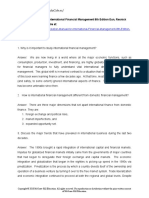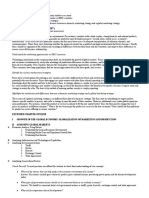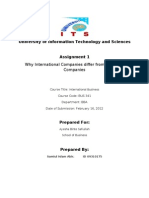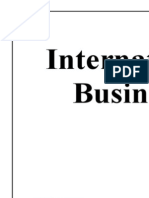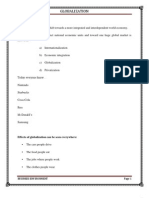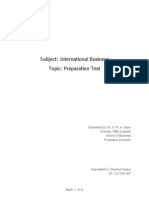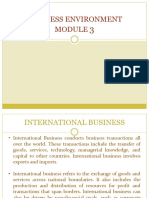Module - 6 International Entrepreneurship Opportunities The Nature of International Entreneurship
Module - 6 International Entrepreneurship Opportunities The Nature of International Entreneurship
Uploaded by
Sourabha K DarshanCopyright:
Available Formats
Module - 6 International Entrepreneurship Opportunities The Nature of International Entreneurship
Module - 6 International Entrepreneurship Opportunities The Nature of International Entreneurship
Uploaded by
Sourabha K DarshanOriginal Title
Copyright
Available Formats
Share this document
Did you find this document useful?
Is this content inappropriate?
Copyright:
Available Formats
Module - 6 International Entrepreneurship Opportunities The Nature of International Entreneurship
Module - 6 International Entrepreneurship Opportunities The Nature of International Entreneurship
Uploaded by
Sourabha K DarshanCopyright:
Available Formats
MODULE -6
INTERNATIONAL ENTREPRENEURSHIP OPPORTUNITIES
THE NATURE OF INTERNATIONAL ENTRENEURSHIP
Simply stated, International entrepreneurship is the process of an
entrepreneur conducting business activities across national boundaries. It
may consist of exporting, licensing, opening a sales office in another country,
or something as simple as placing and satisfying the needs and wants of
target consumers often take place in more than one country. When an
entrepreneur executes his or her business model in more than one country,
international entrepreneurship is occurring.
What a commercial history of only 300 years, the United States is a relative
newcomer to the international business area. As soon as settlements were
established in the New World, American businesses began an active
international trade with Europe. Foreign investors helped build much of the
early industrial trade with Europe as well as much of early industrial base of
the United States. The future commercial strength of the United States
will similarly depend on the ability of U.S. entrepreneurs and established
U.S. companies to take advantage; of markets outside the national borders.
THE IMPORTANCE OF INTERNATIONAL BUSINESS TO THE FIRM
International business has become increasingly important to firms of all
sizes particularly today when every firm is competing in a hypercompetitive
global economy. There can be little doubt that today’s entrepreneur must be
able to move in the world of international business. The successful
entrepreneur will be someone who fully understands how international
business differs from purely domestic business and is able to respond
accordingly. An entrepreneur entering the international market should
address the following questions:
1. Is managing international business from managing domestic business?
2. What are the strategic issues to be resolved in international business
management?
3. What are the options available for engaging in international business?
Divyesh Kumar, GAT, Bangalore 1
4. How should one asses the decision to enter into an international
market?
INTERNATIONAL VERSUS DOMESTIC ENTERPRENEURSHIP
Although international and domestic entrepreneurs alike are concerned with
sales, costs, and profits what differentiates domestic from international
entrepreneurship is the variation in the relative importance of the factors
affecting each decision. International entrepreneurial decisions are more
complex due to such uncontrollable factors as economics, politics, culture
and technology.
Economics
In a domestic business strategy, a single country at a specified level of
economic development is the focus of their entrepreneurial efforts. The
entire country is almost always organized under a single economic system and
has the same currency. Creating a business strategy for a multicountry area
means dealing with differences in: levels of economic development; currency
valuations; government regulations; and banking, venture capital, marketing,
and distribution systems. These differences manifest themselves in each
aspect of the entrepreneur’s international business plan and methods of
doing business.
Stage of Economic Development
The United States is an industrially developed nation with regional variances
of relative income. While needing to adjust the business plan according to
regional differences, an entrepreneur doing business only in the United
States does not have to worry about a significant lack of such fundamental
infrastructures as road, electricity, communication systems, banking
facilities and systems, adequate educational systems, a well-developed legal
system, and established business ethics and norms. These factors vary
greatly in other countries, from those industrialized to those in the process
of developing, and they significantly impact the ability to successfully
engage in international business.
Divyesh Kumar, GAT, Bangalore 2
Balance of Payments
With the present system of flexible exchange rates, a country’s balance of
payments ( the difference between the value of a country’s imports and
exports overtime) affects the valuation of its currency. The valuation of
one country’s currency affects business transactions between countries. At
one time, Italy’s chronic balance of payments deficit led to a radical
depreciation in the value of the Lira, the currency of Italy. Fiat responded
by offering significant rebates on cars sold in the United States. These
rebates cost Fiat very little because fewer dollars purchased many more
liras due to the decreased value of the Lira.
Type of System
Pepsi-cola began considering the possibility of marketing in the former
U.S.S.R. as early as 1959, following the visit of U.S. President Richard Nixon.
When Premier Nikita Khrushchev expressed his approval of Pepsi’s taste,
the slow wheels of East-West trade began moving with Pepsi entering the
former U.S.S.R 13 years later. Instead of using its traditional type of
franchise bottler in this entry, Pepsi used a barter-type arrangement that
satisfied both the socialized system of the former U.S.S.R and the U.S.
capitalist system. In return for receiving technology and syrup from Pepsi,
the former U.S.S.R. provided the company with Soviet vodka and the right
to distribute it in the United States. Many such barter or third-party
arrangements have been used to increase the amount of business activity
with the former U.S.S.R. that Eastern and Central European countries, as
well as other countries in various stages of development and transition.
There are many difficulties in doing business in developing in developing and
transition economics. These problems reflect the gaps in the basic
knowledge of the Western system regarding business plans, product
promotion, marketing, and profits; widely variable rates of return;
nonconvertibility of the currency necessitates finding a counter trade item;
differences in the accounting system; and nightmarish communications.
Political-Legal Environment
The multiplicity of political and legal environments in the international
market creates vastly different business problems, opening some market
Divyesh Kumar, GAT, Bangalore 3
opportunities for entrepreneurs and eliminating others. For example, U.S.
environmental standards have eliminated the possibility of entrepreneurs
establishing ventures to import several models of European cars. Another
significant event in the political-legal environment involves the price
fluctuations in oil and other energy products.
Cultural Environment
The impact of culture on entrepreneurs and strategies is also significant.
Entrepreneurs must make sure that each element in the business plan has
some degree of congruence with the local culture. For example, in some
countries, points of purchase displays are not allowed in retail stores as they
are in the United States.
An increasingly important aspect of cultural environment in some countries
concerns bribes and corruption. How should an entrepreneur deal with these
situations when it may mean losing the business? An example of ethics and
ethical behavior is indicated in the Ethics box.
Sometimes one of the biggest problems is finding a translator. A significant
problem can occur when careless translation occurs. To avoid errors like
these, care should be taken to hire a translator whose native tongue is the
target language and whose expertise matches that of the original authors.
Technological Environment
Technology, like culture, varies significantly across countries. The variations
and availability of technology are often surprising, particularly to an
entrepreneur from a developed country like the United States. While U.S.
firms produced mostly standardized, relatively uniform products that can
be stored to meet industry standards, this is not the case in many countries,
making it more difficult to achieve a consistent level of quality.
New products in a country are created base on the conditions and
infrastructure operant in that country. For example, U.S. car designers can
assume wider roads and less expensive gasoline than European designers.
When these same designers work on transportation vehicles for other parts
of the world, their assumptions need to be significantly altered.
Divyesh Kumar, GAT, Bangalore 4
Strategic Issues
Four strategic issues are of paramount importance to an entrepreneur going
international: (1) the allocation of responsibility between the U.S. and
foreign operations;
(2) the nature of the planning, reporting, and control systems to be used
throughout the international operations; (3) the appropriate organizational
structure for conducting international operations; and (4)the degree of
standardization possible.
ENTREPRENEURIAL ENTRY INTO INTERNATIONAL BUSINESS
There are various ways in entrepreneur can market products internationally.
The method of entry into a market and the mode of operating overseas are
dependent on the goals of the entrepreneur and the company’s strengths and
weaknesses. The modes of entering or engaging in international business can
be divided into three categories; exporting, nonequity arrangements, and
direct foreign investment.
Exporting
Usually, an entrepreneur starts doing international business through
exporting. Exporting normally involves the sale and shipping of products;
manufactured in one country to a customer located in another country.
There are two general classifications of exporting direct and indirect.
Indirect Exporting: Indirect exporting involves having a foreign purchaser
in the local market or using an export management firm. For certain
commodities and manufactured goods, foreign buyers actively seek out
sources of supply and have purchasing offices in markets throughout the
world. An entrepreneur waiting to sell into one of these overseas markets
can deal with one of these buyers. In this case, the entire transaction is
handled as though it were a domestic transaction, even though the goods will
be shipped out of the country. This method of exporting involves the lease
amount of knowledge and risk for the entrepreneur.
Divyesh Kumar, GAT, Bangalore 5
Advantages:
1. Less Risks: The manufacturer who exports indirectly through
intermediaries has to bear fewer risks. He has to bear only
manufacturing risks and not selling risks.
2. Less investment: the manufacturer require less investments as he
need not build up an export marketing set up to export the goods.
3. Specialization: The manufacturer can concentrate only on his
production activities and thus can specialize in production.
4. Suitable for small firms: Because small firms belongs to small scale
sector or cottage sector and faces many problems in negotiating and
selling their products in international markets.
5. Availability of imported inputs: The manufacturer who exports
through export houses or trading houses can avail of imported raw
materials in advance as the export houses are maintaining stocks due
to the policy of grant of additional import licenses.
6. Technical guidance: The manufacturer can also obtain technical
guidance for the manufacture of products from the export houses
through which he exports the products.
7. Assistance in After-Sale-Service: The export houses through
overseas office provide after sale service, which is beyond the scope
of small entrepreneur.
Disadvantages:
1. Lower Prices: The manufacturers may get lower prices for their
goods. This is because; the merchant exporters and other
intermediaries include their commission or margin.
2. Less or no export incentives: The manufacturer may not get adequate
incentives. At times, he may not get incentives at all. This is because,
the intermediary who exports in their names can claim such incentives
3. Lack of positive support form Intermediaries: at times, the
intermediaries may not give positive support to the manufacturer.
This means the intermediaries may promote the exports of only a few
manufacturers with whom they have better relations
4. Second hand information: The manufacturer may not get first hand
information of the export markets. He may receive only second hand
information form the intermediaries. Sometimes, the intermediaries
many not provide information on time.
Divyesh Kumar, GAT, Bangalore 6
5. Lack of control: The manufacturer may not have direct control over
export packaging, pricing, promotion and other marketing activities.
The intermediaries may undertake such activities as per their
convenience. This might affect the sales of the manufacturer.
6. Lower sales: the manufacturer may not be able to get more sales
through the intermediaries. This is because the intermediaries may
be interested in promoting the sales of a particular manufacturer at
the cost of another.
Direct Exporting: If the entrepreneur wants more involvement without any
financial commitment, direct exporting through independent distributors or
the company’s own overseas sales office is a way to get involved in
international business. Independent foreign distribution usually handles
products for firms seeking relatively rapid entry into a large number of
foreign markets. This independent distributor directly contacts foreign
customers and potential customers and takes care of all the technicalities of
arranging for export documentation, financing, and delivery for an
established rate of commission.
Advantages:
1. First hand information
2. Direct control
3. Export incentives
4. Reputation
5. Net returns (No commission is deducted from the sales proceeds
unlike in indirect exporting)
6. Higher prices.
Disadvantages:
1. More risks
2. More investments
3. Lacks specialization
4. Requires vast knowledge on social, cultural, economical and political
environment prevailing in different export markets.
5. Problems for small manufacturers
6. Less economies of distribution: the direct exporter may not be able to
reap economies of large scale in respect of distribution. The
merchant exporter can however, enjoy such economies, as he can
Divyesh Kumar, GAT, Bangalore 7
combine several shipments together, thus gain economies of large-
scale distribution.
Nonequity Arrangements
When market and financial conditions warrant the change, an entrepreneur
can enter into international business by one of three types of nonequity
arrangements; licensing, turn-key projects, and management contracts. Each
of these allows the entrepreneur to enter a market and obtain sales and
profits without direct equity investment in the foreign market.
Licensing:
Licensing involves an entrepreneur who a manufacturer (licensee) is giving a
foreign manufacturer (licensor) the right to use a patent, trademark,
technology, production process, or product in return for the payment of a
royalty. The licensing arrangement is mot appropriate when the
entrepreneur has not intention provides a way to generate incremental
income; a licensing arrangement can be a good method for the entrepreneur
to engage in international business. Unfortunately, some entrepreneurs have
entered into these arrangements without careful analysis and have later
found that they have licensed their largest competitor into business or that
they are investing large sums of time and money in helping the licensor to
adopt the technology or know-how being licensed.
Turn-key projects: Another method by which the entrepreneur can do
international business without much risk is through turn-key projects. The
underdeveloped or lesser-developed countries of the world have recognized
their need for manufacturing technology and infrastructure and yet do not
want to turn over substantial portions of their economy to foreign
ownership. One solution to this dilemma has been to have a foreign
entrepreneur build a factory or other facility, train the workers, train the
management, and then turn it over to local owners once the operation is
going, hence the name turn-key the management, and then turn it over to
local owners once the operation
is going, hence the name turn-key operation.
Divyesh Kumar, GAT, Bangalore 8
Entrepreneurs have found then turn-key project an attractive
alternative, initial profits can be made from this method, and follow-up
export sales can also result. Financing is provided by the local company or
the government with periodic payments being made over the life of the
project.
Management Contracts: A final non equity method the entrepreneur can use
in international business is the management contract. Several entrepreneurs
have successfully entered international business by contracting their
management techniques and skills. The management contract allows the
purchasing country to gain foreign expertise without giving ownership of its
resources to a foreigner. For the entrepreneur, the management contract is
another way of entering a foreign market without a large equity investment.
Direct Foreign Investment:
The wholly owned foreign subsidiary has been a preferred mode of
ownership for entrepreneurs using direct foreign investment for doing
business in international markets. Joint ventures and minority and majority
equity positions are also methods for making direct foreign investments.
The percentage of ownership obtained in the foreign venture by the
entrepreneur is related to the amount of money invested, the nature of the
industry, and the rules of host government.
Minority Interests: Japanese companies have been frequent uses of the
minority equity position in direct foreign investment. A minority interest
can provide a firm with a source of raw materials or a relatively captive
market for its products. Entrepreneurs have used minority positions to gain
a foothold or acquire experience in a market before making a major
commitment. When the minority shareholder has something of strong value,
the ability to influence the decision-making process is often far in excess of
the amount of ownership.
Joint Ventures: Another direct foreign investment method used by
entrepreneurs to enter foreign markets is the joint venture. Although a
joint venture can take on many forms, in its most traditional form, two firms
(for example, one U.S firm and one German firm) get together and form a
third company in which they share equity. Joint ventures have been used by
entrepreneurs most often in two situations (1) when the entrepreneur wants
Divyesh Kumar, GAT, Bangalore 9
to purchase local knowledge as well as an already established marketing or
manufacturing facility, and (2) when rapid entry into a market is needed.
Sometimes joint ventures are dissolved and the entrepreneur takes 100
percent ownership.
Majority Interest: Another equity method for the entrepreneur to enter
international markets is to purchase a majority interest in a foreign
business. In a technical sense, anything over 50 percent of the equity in a
firm is majority interest. The majority acquired firm’s local identity. When
entering a volatile international market, some entrepreneurs take a smaller
position, which they increase up to 100 percent as sales and profits occur.
Mergers: An entrepreneur can obtain 100 percent ownership to ensure
complete control. Many U.S entrepreneurs desire complete ownership and
control in cases of foreign investments. If the entrepreneur has the capital,
technology and marketing skills required for successful entry into a market,
there may be no reason to share ownership.
Mergers and acquisitions have been used significantly in engaging in
international business as well as within the United States. During period of
intense merger activity, entrepreneurs may spend significant time searching
for a firm to acquire and then finalizing the transaction. While any merger
should reflect basic principles of any capital investment decision and make a
net contribution to shareholders’ wealth, the merits of a particular merger
are often difficult to assess. Not only do the benefits and cost a merger
need to determined, but special accounting, legal, and tax issues must be
addressed. The entrepreneur therefore must have a general understanding
of the completely of integrating an entire company into present operations.
BARRIERS TO INTERNATINAL TRADE
There are varying attitudes throughout the world concerning trade.
Starting around 1947 with the development of general trade agreements and
the reduction of tariffs and other trade barriers, there has been an overall
positive atmosphere concerning trades.
Divyesh Kumar, GAT, Bangalore 10
General Agreement on Tariffs and Trade (GATT)
One of the longest-lasting agreements on trade is the General Agreement on
Tariffs and Trade (GATT), which was established in 1947 under U.S.
leadership, GATT is a multilateral agreement with the objective of
liberalizing trade by eliminating or reducing tariffs, subsidies, and import
quotas. GATT membership includes over 100 nations and has had eight
rounds of tariffs reductions, the most recent being the Uruguay Round that
lasted from 1986 to 1993. In each round, mutual tariff reductions are
negotiated between member nations and monitored by a mutually-agreed-
upon system. If a number country feels that a violation has occurred, it can
ask for an investigation by the Geneva-based administrators of GATT. If
the investigation uncovers a violation, member countries ca be asked to
pressure the violating country to change its policy and conform to the
agreed-upon tariffs and agreements. Sometimes this pressure has not been
sufficient to get an offering country to change. While GATT has assisted in
developing more unrestricted trade, its voluntary membership gives it little
authority to ensure that this type of trade will occur.
Increasing Protectionist Attitudes
The support of GATT goes up and down. Although down in the 1970s, the
support increased in the 1980s due to the rise in protectionist pressures in
many industrialized countries. The renewed support reflected three events.
First, the world trading system was strained by the persistent trade deficit
of the United States, the world’s largest economy, a situation that caused
adjustments in such industries as automobiles, semi conductors, steel and
textiles,. Second, the economic success of a country perceived as not
playing by the rules (e.g., Japan) has also strained the world’s largest trader
and the perception that its internal markets are, in effect, closed to imports
and foreign investment have caused problems. Finally, in response to these
pressures, many countries have established bilateral voluntary export
restraints to circumvent GATT. The economic prosperity of the 1990s has
lessened the interest in GATT.
Trade Blocs and Free Trade Areas
Divyesh Kumar, GAT, Bangalore 11
Around the world, groups of nations are banding together to increase trade
and investment between nations in the group and exclude those nations
outside the group. One little-known agreement between the United States
and Israel, signed in 1985, establishes Free Trade Area(FTA) between the
two nations. All tariffs and quotas except on the certain agricultural
products were phased out over a 10-year period. In 1989, an FTA went into
effect between Canada and the United, States that phased out tariffs and
quotas between the two countries, which are each other’s largest trading
partners.
Many trading alliance have evolved in the Americans. In 1991, the
United States signed a framework trade agreement with Argentina, Brazil,
Paraguay, and Uruguay to support the development of more liberal trade
elations. The United States has also signed bilateral trade agreements with
Bolivia, Chile, Colombia, Costa Rica, Ecuador, EI Salvador, Honduras, Peru,
and Venezuela. The North American Free Trade Agreement (NAFTA) among
the United States, Canada, and Mexico is a much-publicized agreement; to
reduce trade barriers and quotas and encourage investment among the three
countries. Simi9larly, the Americas, Argentina, Brazil, Paraguay and Uruguay
operate under the Treaty of Asuncion, which created the Mercosul trade
Zone, a free-trade zone among; the countries
Divyesh Kumar, GAT, Bangalore 12
You might also like
- Solution Manual For International Financial Management 8th Edition Eun, ResnickDocument9 pagesSolution Manual For International Financial Management 8th Edition Eun, Resnicka456989912No ratings yet
- The New Business Venture Chapter 4Document5 pagesThe New Business Venture Chapter 4Vishal AnandNo ratings yet
- Individual Project I.B.Document6 pagesIndividual Project I.B.Nimanshi JainNo ratings yet
- International MarketingDocument6 pagesInternational MarketingAbviel YumulNo ratings yet
- Mita Paryani: International Business ProjectDocument12 pagesMita Paryani: International Business ProjectSunny AhujaNo ratings yet
- International EntrepreneurshipDocument4 pagesInternational EntrepreneurshipSudhir Kumar Yadav100% (1)
- International Marketing CH1Document7 pagesInternational Marketing CH1Nour Ali100% (1)
- Electronic MarketingDocument17 pagesElectronic MarketingMuhammad NaveedNo ratings yet
- IB unit IDocument6 pagesIB unit Iutsavpatel202002No ratings yet
- BBA - GGS Indraprastha University BBA-308 INTERNATIONAL Business ManagementDocument4 pagesBBA - GGS Indraprastha University BBA-308 INTERNATIONAL Business ManagementKunal KalraNo ratings yet
- Importance of International Management and Its ImpactsDocument7 pagesImportance of International Management and Its ImpactsShabbirAhmad50% (2)
- Bib2014 - Exercise 1Document5 pagesBib2014 - Exercise 1mimiasheikhNo ratings yet
- Notes of Intl - BizDocument262 pagesNotes of Intl - BizPooja AnamNo ratings yet
- IB Project - HR - TYBBI - Roll No.44Document12 pagesIB Project - HR - TYBBI - Roll No.44Mita ParyaniNo ratings yet
- IB Chapter 1 GlobalizationDocument4 pagesIB Chapter 1 GlobalizationTaHir ShEikhNo ratings yet
- Chapter 8 Study GuideDocument5 pagesChapter 8 Study GuideHieu NguyenNo ratings yet
- Why International Business Differ From Domestic BusinessDocument6 pagesWhy International Business Differ From Domestic BusinessSamiul Islam Abir100% (3)
- International Business TybbiDocument7 pagesInternational Business Tybbichoco_pie_952100% (1)
- Globalization 094902Document5 pagesGlobalization 094902labutanrosabel0358No ratings yet
- MODULES-2Document10 pagesMODULES-2Hazel Ann PelareNo ratings yet
- Unit 3 Entrepreneurship: Indian and Global Context StructureDocument27 pagesUnit 3 Entrepreneurship: Indian and Global Context StructurePranay GuptaNo ratings yet
- The Nature of International EntrepreneurshipDocument2 pagesThe Nature of International EntrepreneurshipRicha Kushwaha100% (2)
- International BusinessDocument19 pagesInternational BusinessHujjat UllahNo ratings yet
- Opportunity Recognition, International Entrepreneurship and EntrepreneurshipDocument14 pagesOpportunity Recognition, International Entrepreneurship and EntrepreneurshipAhmed Shayer LabibNo ratings yet
- Lesson 1 IBT 2023Document25 pagesLesson 1 IBT 2023bryvinsarmientoNo ratings yet
- Unit 2 Environment of IB: 1 DR - Tr.Kalai Lakshmi/Mba/Global Business Management/ Unit 2Document23 pagesUnit 2 Environment of IB: 1 DR - Tr.Kalai Lakshmi/Mba/Global Business Management/ Unit 2GracyNo ratings yet
- UNIT 7 - Global Aspects of Entrepreneurship 1Document15 pagesUNIT 7 - Global Aspects of Entrepreneurship 1Altaire Gabrieli DayritNo ratings yet
- Globalization: Effects of Globalization Can Be Seen EverywhereDocument23 pagesGlobalization: Effects of Globalization Can Be Seen Everywherejaanbaaz1No ratings yet
- Chapter 2Document2 pagesChapter 2CASAQUIT, IRA LORAINENo ratings yet
- Globalization (Or Globalisation) Describes The Process by Which Regional Economies, SocietiesDocument56 pagesGlobalization (Or Globalisation) Describes The Process by Which Regional Economies, SocietiesFathima TarannumNo ratings yet
- Key Factors Influencing International Business: Learning ValueDocument18 pagesKey Factors Influencing International Business: Learning ValueBipin B ParajuliNo ratings yet
- IB Unit 1Document20 pagesIB Unit 1Saima JamalNo ratings yet
- 3-Key Factors Influencing International BusinessDocument17 pages3-Key Factors Influencing International Businessfrediz7994% (32)
- Master of Business Administration-MBA Semester 4 MB0053 - International Business Management AssignmentDocument8 pagesMaster of Business Administration-MBA Semester 4 MB0053 - International Business Management AssignmentNisha NishadNo ratings yet
- International Marketing NOTESDocument106 pagesInternational Marketing NOTESasobasuNo ratings yet
- Subject: International Business Topic: Preparation TestDocument5 pagesSubject: International Business Topic: Preparation TestShamiul HoqueNo ratings yet
- Access To Markets - SyllabusDocument61 pagesAccess To Markets - SyllabusВлад СтупакNo ratings yet
- International BusinessDocument4 pagesInternational BusinessSurya BathamNo ratings yet
- Introduction To International Business Unit - I: Gratulent PublicationsDocument77 pagesIntroduction To International Business Unit - I: Gratulent PublicationsNakul RathiNo ratings yet
- IBE AssignmentDocument7 pagesIBE AssignmentAishwarya KhopkarNo ratings yet
- Definition of International BusinessDocument23 pagesDefinition of International Businessvini2710No ratings yet
- Global Firm DefinitionDocument8 pagesGlobal Firm DefinitionAmir HamzahNo ratings yet
- Effective International Business and Management Strategies InvestmentDocument18 pagesEffective International Business and Management Strategies InvestmentAhmed KumarNo ratings yet
- Global TradeDocument7 pagesGlobal TradeFRANCIS EDWIN MOJADONo ratings yet
- BE Unit 3Document43 pagesBE Unit 3Kiran BendeNo ratings yet
- SIR A ENTREPfema)Document22 pagesSIR A ENTREPfema)Lhiereen AlimatoNo ratings yet
- Modules in Internationa Business and TradeDocument133 pagesModules in Internationa Business and TradeCRISTINE JOY LAUZ100% (1)
- Assignment 3Document11 pagesAssignment 3Vansh DuaNo ratings yet
- SM CH 1 Eun 9Document9 pagesSM CH 1 Eun 9Đặng Quỳnh Trang100% (1)
- M 5 International Entrepreneurship Opportunities: OduleDocument35 pagesM 5 International Entrepreneurship Opportunities: OduleNageshNo ratings yet
- Ch-1 IMDocument15 pagesCh-1 IMJohnny KinfeNo ratings yet
- What Is International BusinessDocument4 pagesWhat Is International BusinessRavimohan RajmohanNo ratings yet
- Unit 7: Global Aspects of EntrepreneurshipDocument14 pagesUnit 7: Global Aspects of EntrepreneurshipAngela Inesoria INo ratings yet
- IfffDocument47 pagesIfffARJUN VNo ratings yet
- Unit 3Document16 pagesUnit 3Aditya SinghNo ratings yet
- Submitted By:: Sagar Sangani 91 Jaiveer Duggal 92 Swati Tikku 93 Swapnali Ligam 94 Chandni Parmar 95 Rajdeep Pandere 96Document37 pagesSubmitted By:: Sagar Sangani 91 Jaiveer Duggal 92 Swati Tikku 93 Swapnali Ligam 94 Chandni Parmar 95 Rajdeep Pandere 96riten9090No ratings yet
- Jurnal Vol. IV No.1 JANUARI 2013 - SupanjiDocument11 pagesJurnal Vol. IV No.1 JANUARI 2013 - SupanjiIchsan SetiadiNo ratings yet
- International Marketing CH-1Document11 pagesInternational Marketing CH-1Shalle said AdenNo ratings yet
- Export to Explode Cash Flow and Profits: Creating New Streams of Business in Asia, Africa and the Americas with Little InvestmentFrom EverandExport to Explode Cash Flow and Profits: Creating New Streams of Business in Asia, Africa and the Americas with Little InvestmentNo ratings yet
- CCIP in DPi AnalysisDocument22 pagesCCIP in DPi AnalysisAhmedNo ratings yet
- Madagascar 2014Document12 pagesMadagascar 2014HayZara MadagascarNo ratings yet
- Integreon Ethics WhitepaperDocument16 pagesIntegreon Ethics WhitepaperNaveen KumarNo ratings yet
- Investment Summary: Biding For The Fruitful TimeDocument32 pagesInvestment Summary: Biding For The Fruitful TimeHUY LÊ NHỰTNo ratings yet
- Export Import Procedures and Documentation PDF IndiaDocument2 pagesExport Import Procedures and Documentation PDF IndiaCarolyn0% (1)
- SourcingDocument16 pagesSourcingAMRITA PANDEY100% (1)
- HE Ocator Search Ends HereDocument27 pagesHE Ocator Search Ends HerecharuNo ratings yet
- Vietnam Electronics IndustryDocument11 pagesVietnam Electronics Industrykevin ramonNo ratings yet
- Footwear Industry Bangladesh - A Comparative StudyDocument66 pagesFootwear Industry Bangladesh - A Comparative StudyRakib Khan86% (7)
- Cold Chain KenyaDocument4 pagesCold Chain Kenya최두영No ratings yet
- Marc - Donnelly - Associates - Inc. - v. - Agregado PDFDocument11 pagesMarc - Donnelly - Associates - Inc. - v. - Agregado PDFCamille CruzNo ratings yet
- Mgt210 Term Paper On: BSRM Steels LTDDocument48 pagesMgt210 Term Paper On: BSRM Steels LTDDipu VaiNo ratings yet
- CHAPTER 11 - International TradeDocument6 pagesCHAPTER 11 - International TradeirfanNo ratings yet
- China Rice Flour Products Market ReportDocument10 pagesChina Rice Flour Products Market ReportAllChinaReports.comNo ratings yet
- Role of Services in EconomyDocument46 pagesRole of Services in EconomySomesh SrivastavaNo ratings yet
- TI cycles-TIIDocument20 pagesTI cycles-TIIrajaaryan92No ratings yet
- Contemporary International Business in The Asia-Pacific Region-101-200!1!97Document97 pagesContemporary International Business in The Asia-Pacific Region-101-200!1!97NGỌC NGUYỄN THỊ NHƯNo ratings yet
- Krugman - Chap 1Document22 pagesKrugman - Chap 1Lodhi Ismail0% (1)
- NEW CLOTH MARKET: The Cotton Textiles Export Promotion Council (Texprocil) - 57 Annual General Meeting (Published in The Nov. 2011 IssueDocument6 pagesNEW CLOTH MARKET: The Cotton Textiles Export Promotion Council (Texprocil) - 57 Annual General Meeting (Published in The Nov. 2011 IssueganariNo ratings yet
- Financial Products & ServicesDocument72 pagesFinancial Products & ServicesMuhammad Shahzad KhurramNo ratings yet
- BERF Ethiopia Foreign Exchange For BusinessesDocument83 pagesBERF Ethiopia Foreign Exchange For Businessesmsurafel385No ratings yet
- E Commerce FIA Memory AidDocument5 pagesE Commerce FIA Memory Aidangelica arnaizNo ratings yet
- Engineering Industry in IndiaDocument3 pagesEngineering Industry in Indiavenkatchetan6No ratings yet
- IGNOU Political Science Material - Modern Indian Political Thought WWW Prep4civils ComDocument331 pagesIGNOU Political Science Material - Modern Indian Political Thought WWW Prep4civils ComPrep4Civils91% (11)
- Research SillanwaliDocument33 pagesResearch SillanwaligiimranNo ratings yet
- Exim Bank GlaDocument47 pagesExim Bank GlaDr-Shefali GargNo ratings yet
- Chapter 6 Medium and Long Term Financing: Ibm I-G2 International Trade Finance BU1243-G2Document13 pagesChapter 6 Medium and Long Term Financing: Ibm I-G2 International Trade Finance BU1243-G2Mohit SahajpalNo ratings yet
- Export PromotionDocument16 pagesExport Promotionanshikabatra21167% (3)
- Application For VAT Zero RatingDocument9 pagesApplication For VAT Zero RatingHanabishi RekkaNo ratings yet
- Module 3 MicroeconomicDocument2 pagesModule 3 MicroeconomicChristian VillanuevaNo ratings yet
